April 1, 2013
by Mikhail Elyashberg, Leading Researcher, ACD/Labs
Lycojaponicumin D
Plants of the Lycopodium species (Lycopodiaceae) are known to be a rich source of Lycopodium alkaloids possessing unique heterocyclic frameworks, such as huperzine A, fawcettimine, and serratinine, which have attracted great interest from biogenetic, synthetic, and biological perspectives. As a representative plant of the Lycopodiaceae family, Lycopodium japonicum Thunb. ex Murray has historically been used as a traditional Chinese medicine for the treatment of contusions, strains, and myasthenia. Previously Wang et al [1] reported three trace Lycopodium alkaloids, lycojaponicumins A and B with a 5/5/5/5/6 pentacyclic ring system and lycojaponicumin C with a 6/5/5/6 tetracyclic ring system, isolated from this plant. The structure of Lycojaponicumin A was elucidated with the aids of ACD/Structure Elucidator in an earlier Elucidation of the Month.
In the next work [2] the same group described the discovery of structurally unique alkaloid, Lycojaponicumin D (1), with an unprecedented 5/7/6/6 tetracyclic skeleton formed by an unusual C3-C13 linkage.
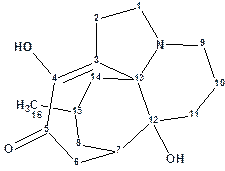
1
Its structure was determined by extensive spectroscopic methods and X-ray crystallography. Here we will describe the structure elucidation of 1 by utilizing Structure Elucidator.
Lycojaponicumin D (1) was obtained as a white amorphous powder, and its molecular formula was established to be C16H23NO3 by HRESIMS at m/z 278.1747 [M+H]+ (calculated 278.1751), accounting for 6 degrees of unsaturation. The IR spectrum of 1 (Figure 1) showed the absorption band of OH or NH groups at 3391 cm-1 and a band of α,β-unsaturated keto group or amide group at 1677 cm-1.
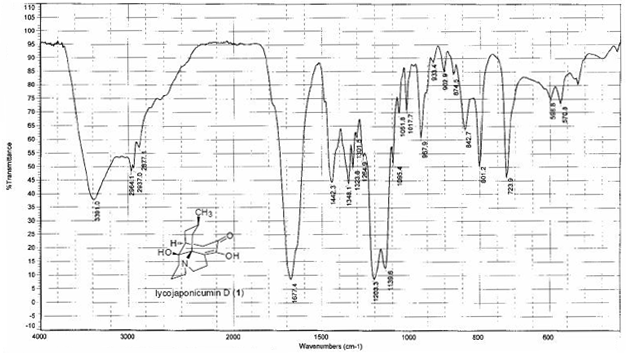
Figure 1. IR absorption spectrum of Lycojaponicumin D (1).
The original work [1] contains 1D NMR data, as well as graphical representations of key HMBC and COSY correlations, which are presented in Table 1.
Table 1. Spectroscopic NMR data of Lycojaponicumin D (1).
| Label | δC | δC calc | CHn | δH | M(J) | COSY | HMBC |
| C 1 | 49.3 | 49.84 | CH2 | 2.76 | u | ||
| C 1 | 49.3 | 49.84 | CH2 | 3.25 | u | 3.1 | C 13, C 3, C 9 |
| C 2 | 29.1 | 21.67 | CH2 | 3.1 | u | 3.25 | C 4, C 3, C 13 |
| C 2 | 29.1 | 21.67 | CH2 | 2.67 | u | ||
| C 3 | 133 | 136.1 | C | ||||
| C 4 | 143.1 | 148.1 | C | ||||
| C 5 | 195.8 | 197.1 | C | ||||
| C 6 | 42.6 | 40.66 | CH2 | 2.75 | u | ||
| C 6 | 42.6 | 40.66 | CH2 | 2.83 | u | 2.09 | |
| C 7 | 41.1 | 43.41 | CH | 2.09 | u | 2.83, 1.98 | C 12, C 13, C 5 |
| C 8 | 36 | 36.15 | CH2 | 1.98 | u | 1.40, 2.09 | |
| C 8 | 36 | 36.15 | CH2 | 1.35 | u | ||
| C 9 | 51.1 | 47.78 | CH2 | 2.86 | u | 2.16 | |
| C 9 | 51.1 | 47.78 | CH2 | 2.44 | u | ||
| C 10 | 20.4 | 21.15 | CH2 | 2.16 | u | 2.86, 1.77 | C 12 |
| C 10 | 20.4 | 21.15 | CH2 | 1.58 | u | ||
| C 11 | 32 | 34.2 | CH2 | 1.77 | u | 2.16 | C 13 |
| C 11 | 32 | 34.2 | CH2 | 1.5 | u | ||
| C 12 | 70.7 | 74.92 | C | ||||
| C 13 | 73.8 | 72.32 | C | ||||
| C 14 | 37.7 | 40.42 | CH2 | 1.37 | u | ||
| C 14 | 37.7 | 40.42 | CH2 | 1.74 | u | 1.4 | C 3 |
| C 15 | 25.1 | 27.53 | CH | 1.4 | u | 1.98, 1.74, 0.89 | C 13 |
| C 16 | 21.5 | 23.65 | CH3 | 0.89 | u | 1.4 |
Using the data in Table 1, Structure Elucidator created the Molecular Connectivity Diagram shown in Figure 2.
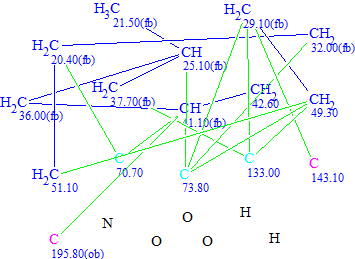
Figure 2. Molecular connectivity diagram of Lycojaponicumin D (1).
In spite of the presence of three light blue carbon atoms C 70.70, C 73.80 and C 133.00 (their hybridization state was defined ambiguously – sp2 or sp3) it is possible to suggest that no user intervention is necessary because the molecule is relatively small (C16H23NO3) while the number of HMBC and COSY correlations is large enough. No nonstandard correlation was detected by the MCD checking, and therefore a Strict Structure Generation was initiated. The results: k = 3→2, tg = 0.005 s.
Two resulted structures ranked by calculated 13C average deviations are presented in Figure 3.
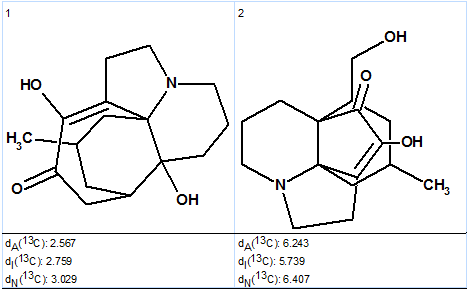
Figure 3. The ranked output structural file for Lycojaponicumin D.
Figure 3 demonstrates that the complete structure of Lycojaponicumin D, containing an unprecedented 5/7/6/6 tetracyclic skeleton, was automatically and instantly elucidated by the system: the first ranked structure coincides with structure 1. As d(2)-d(1) ≅ 3-4 ppm it is evident that structure 1 and its NMR chemical shift assignment (see structure 1a) were determined reliably without the need for X-ray crystallography.
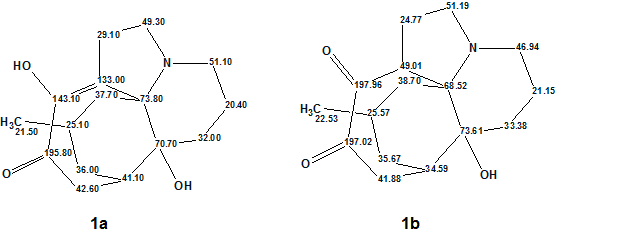
Analysis of structure 1 by the optional aids of ACD/ChemSketch allowed us to determine that along with the structure 1, its tautomeric form 1b is possible. Comparison of experimental chemical shifts (1a) with predicted for structure 1b shows that Lycojaponicumin D isolated by authors [1] does exist in the form 1a, as there are no chemical shifts near 130 and 140 ppm in the tautomer 1b.
1. Lycojaponicumins A – C, Three Alkaloids with an Unprecedented Skeleton from Lycopodium japonicum. X.-J.Wang, G.-J. Zhang, P.-Y. Zhuang, Y. Zhang, S.-S. Yu, X.-Q. Bao, D. Zhang, Y.-H. Yuan, N.-H. Chen, S.-G. Ma, J. Qu, Y. Li. Org. Lett., 14(10):2614–2617, 2012.
2. Lycojaponicumins D and E: Two New Alkaloids from Lycopodium japonicum. X.-J. Wang, Y.-B. Liu, L. Li, S.-S. Yu, H.-N. Lv, S.-G. Ma, X.-Q. Bao, D. Zhang, J. Qu, Y. Li. Org. Lett., 14(22):5688–5691, 2012. doi: 10.1021/ol302701y. Epub 2012 Nov 2.


